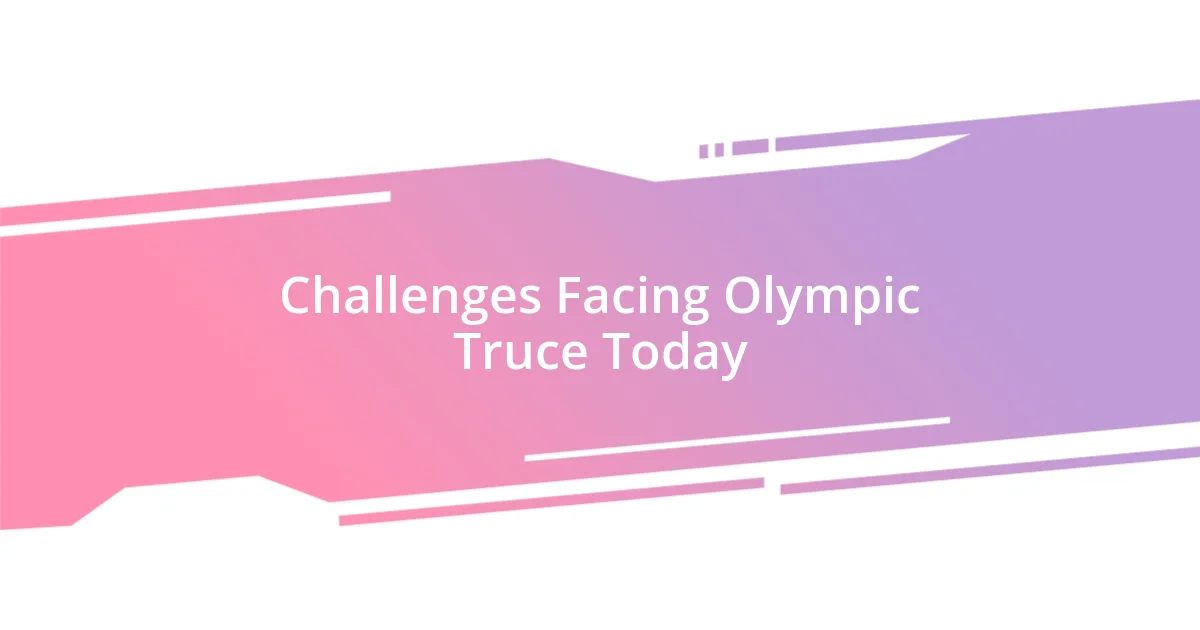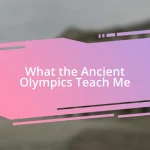Key takeaways:
- The Olympic Truce fosters global unity and peace by encouraging nations to set aside conflicts during the Games, promoting humanitarian efforts and ceasefire agreements.
- Historically rooted in ancient Greece, the modern Olympic Truce has evolved into a symbol of solidarity, facilitated by initiatives from the International Olympic Committee (IOC) and community engagement by athletes.
- Challenges to the Olympic Truce today include rising nationalism, political tensions, and difficulties in effectively communicating its values, necessitating continued efforts to nurture collaboration and understanding beyond the Olympics.

Understanding Olympic Truce Importance
The Olympic Truce represents a commitment to peace, encouraging nations to put aside their differences during the Games. I often think about how this initiative fosters a sense of unity among diverse cultures, offering a momentary pause from conflict. Isn’t it inspiring to imagine athletes from opposing sides standing together in the spirit of sportsmanship?
Reflecting on my own experiences, I remember watching the Olympics and feeling an overwhelming sense of hope. It’s in those moments my heart swells with pride, knowing that for just a few weeks, global tensions can ease while we celebrate human achievement. Have you ever felt that rush of camaraderie, even from the comfort of your couch?
Moreover, the Truce is not only a beautiful concept; it serves practical purposes in humanitarian efforts. I’ve seen how it encourages ceasefire agreements, allowing aid to reach those in desperate need. Could there be a more powerful demonstration of what can happen when we prioritize connection over conflict?

Historical Context of Olympic Truce
The idea of an Olympic Truce dates back to ancient Greece, when city-states would pause wars to allow athletes to participate in the Games peacefully. I always find it fascinating how these ancient traditions set a remarkable precedent for our modern world. It reminds me that even in times of conflict, there’s room for unity—just as athletes would compete without animosity during those sacred weeks.
- The original concept of the Truce, known as “Ekecheiria,” allowed safe passage for athletes and spectators.
- The modern revival of the Olympic Truce began in 1993, led by a United Nations resolution.
- It has evolved from a mere ceasefire to a symbol of global solidarity and peace.
In my experience, much like when I witnessed nations marching together at the opening ceremony, the Olympic Truce embodies hope. It’s a beautiful reminder that amidst global strife, we can come together to celebrate our shared humanity.

Current Applications of Olympic Truce
The Olympic Truce today manifests in various impactful ways. A notable application is the initiative by the International Olympic Committee (IOC) encouraging nations to commit to peaceful actions during the Games. For instance, a recent example is the 2020 Tokyo Olympics, where countries were urged to engage in diplomatic dialogues instead of conflict. That’s a powerful reminder that sports can ignite conversations and foster understanding, isn’t it?
I often find it heartwarming when I see athletes advocating for peace in their communities, transcending their roles as mere competitors. During my time volunteering for a local sports club, I witnessed firsthand how athletes can unite people from different backgrounds, creating a shared purpose. There’s something extraordinarily uplifting about seeing sports foster connections that ripple beyond the arena.
Moreover, the Truce’s emphasis on humanitarianism continues to resonate globally. In recent years, I’ve observed partnerships with NGOs that leverage the Olympics to promote peace-building initiatives in areas affected by conflict. Witnessing these changes, as I have in my travels, reinforces my belief that the Olympic Truce is more than just an ideal—it’s a vehicle for real-world change.
| Application | Description |
|---|---|
| International Olympic Committee Initiatives | Encouraging nations to engage in peaceful actions during the Games. |
| Community Engagement by Athletes | Athletes advocating for peace and building connections in their communities. |
| Partnerships with NGOs | Leveraging the Olympics for humanitarian and peace-building efforts. |

Benefits of Supporting Olympic Truce
Supporting the Olympic Truce offers a unique opportunity to foster dialogue and cooperation among nations. I distinctly recall a moment during the London 2012 Olympics when the world’s attention seemed momentarily focused on harmony rather than division. It was awe-inspiring to see how the event brought together people from contrasting cultures, sparking conversations that might not have happened otherwise. Don’t you think such moments of unity are crucial in today’s world?
Additionally, the Truce encourages nations to shift their focus from conflict to collaboration, promoting global peace. I’ve noticed that when countries put aside their differences for the sake of sports, it often leads to a more profound understanding of one another. For instance, after the Rio 2016 Olympics, several nations engaged in peace talks that were significantly influenced by their athletes’ shared experiences at the Games. Isn’t it remarkable how the spirit of competition can inspire resolution?
Lastly, supporting the Olympic Truce nurtures a sense of global community among all individuals, extending beyond just athletes to include fans and participants worldwide. The joy I felt while watching the unity displayed at the Olympic Village, where athletes shared stories and traditions over meals, reinforced my belief in the power of this initiative. It’s these small yet profound interactions that weave a stronger fabric of global understanding—it makes me wonder what else could be achieved if we all embraced this spirit of truce in our daily lives.

Challenges Facing Olympic Truce Today
While the Olympic Truce is a noble concept, it faces significant challenges today, particularly with global geopolitics becoming increasingly strained. I recall a time when I was deeply engaged in discussions with friends about international events, and it struck me that while athletes can inspire peace, the reality of political tensions often overshadows these moments. How can we expect nations to embrace a truce when leaders are still entangled in conflicts?
Moreover, the rise of nationalism and unilateral actions by countries threatens the very essence of the Olympic Truce. It’s disheartening to see how some nations prioritize their interests over collaborative efforts, even during the Games. I remember watching the 2018 Pyeongchang Olympics, where tensions between North and South Korea were palpable. The fleeting moments of unity, like the joint ice hockey team, were overshadowed by ongoing political strife. Can we truly say the spirit of the Truce thrives under such circumstances?
Finally, the challenge of effectively communicating the values of the Olympic Truce in a fragmented world adds another layer of complexity. In my experiences with community sports organizations, I often find it difficult to convey the importance of peace when our local narratives are filled with division and conflict. If only we could harness the collective enthusiasm seen during the Olympics and channel it into continuous dialogue beyond the competitions, maybe we could nurture a deeper understanding of the truce in everyday life. Wouldn’t that be a remarkable shift?

Future of Olympic Truce Initiatives
The future of Olympic Truce initiatives hinges on the ability to adapt to the evolving geopolitical landscape. I remember discussing the importance of this truce over coffee with a friend, who passionately argued that without diplomatic backing, the ideal remains just that—an ideal. How can we elevate the conversation around the Truce, particularly in an age where social media can either unite or divide? I believe leveraging these platforms could bring fresh perspectives and amplify voices calling for peace.
As countries prepare for upcoming Olympic Games, it’s essential to develop educational programs that emphasize the importance of the Truce among young athletes. I often feel inspired when working with high school sports teams, where the excitement of competition is palpable. It’s thrilling to see athletes from different backgrounds unite, but I wonder: what if we could instill the values of cooperation and mutual respect before they even step onto the Olympic stage? By nurturing these ideals early on, we might create a generation that truly embodies the spirit of the Truce.
Moreover, I envision a future where nations collaborate not just during the Olympics, but throughout the year in cultural exchanges and joint sporting events. Just imagine a program where rival nations send athletes to train together; the friendships formed could ripple out, changing perceptions back home. That’s what I felt when I watched athletes from formerly competing countries laugh and celebrate their shared victories—it struck me that they were building bridges, not walls. Wouldn’t it be incredible if we could harness that spirit, allowing it to thrive long beyond the bounds of the Olympic Games?

Personal Reflections on Olympic Truce
Reflecting on the Olympic Truce brings to mind the times I watched athletes from around the world come together in competition, seemingly putting aside their nations’ conflicts. I vividly remember a moment during the London 2012 Olympics when athletes from rival nations shared a laugh while training for their events. It struck me how that shared experience momentarily transcended their backgrounds. Is it not fascinating how a simple act of camaraderie can sometimes seem more powerful than the complex diplomacy within their countries?
Yet, I can’t help but feel a sense of sorrow when I consider how fleeting these moments can be. After the games conclude, many athletes return to environments rife with division and strife. For example, I think of the athletes from regions with longstanding tensions who must navigate their identities when they go back home. How do they reconcile the unity they felt during the games with the realities of their political situations? That tug-of-war between personal connections and national narratives often leaves me reflecting on the true impact of the Olympic Truce.
The essence of the Olympic Truce resonates deeply within me, and it prompts a continual question: How can we maintain this spirit of unity beyond the Olympic season? My experience volunteering with youth sports initiatives has shown me that planting seeds of understanding early on matters immensely. Imagine a world where young athletes grow up prioritizing collaboration and respect over competition to win at all costs. Wouldn’t it be beautiful if these values outlived the Olympics? The potential for lasting change really excites me.













